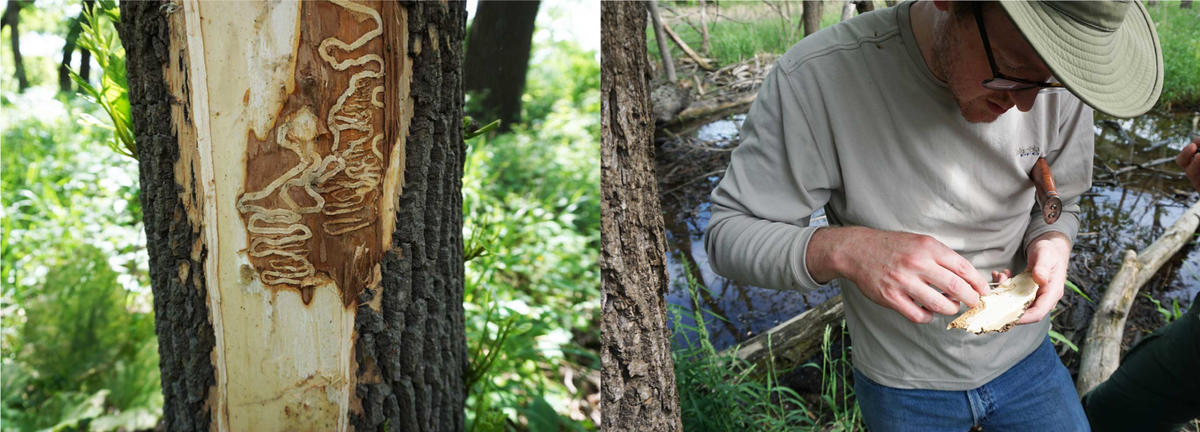
Background
In the past decade, the invasive emerald ash borer (EAB, Agrilus planipennnis) has caused the death of thousands of ash trees across Minnesota. Larval EAB feed on the layer of ash wood just beneath the bark, leaving behind tunnels (known as galleries) that can stretch up to 20 inches long. This feeding also spreads disease-causing fungi, which can cause tree decay and create hazardous conditions if trunks become too weak to stand.
Other fungal species associated with EAB-infestation may be entomopathogenic—that is, capable of parasitizing the insect and killing it or slowing its spread. These fungi would be promising candidates for EAB biocontrol measures.
Before this project, managers weren’t sure which fungi have been associated with EAB infestation in Minnesota. This project team has identified those species for certain and, in doing so, opened up new possibilities for managing one of our state’s most devastating tree pests. In local samples, researchers have also been on the lookout for signs of another major fungal pathogen, ash dieback.
Project phases
Research project title: Fungi in Ash Trees: towards protecting trees from emerald ash borer and new diseases
Taxa: Invertebrate
Species: Emerald ash borer (Agrilus planipennnis)
Project status: Completed in 2022
Funding: $500,000
Research questions
- What fungi occur in trees infested with EAB?
- What fungi contribute to canker formation, wood decay, and tree death following EAB infestation?
- Are any of the fungi associated with EAB capable of infecting and killing the insect?
Research project title: Studies of Entomopathogenic Fungi for Effective Biocontrol of the Emerald Ash Borer - Phase II
Taxa: Invertebrate
Species: Emerald ash borer (Agrilus planipennnis)
Project status: In progress (started January 2023)
Funding: $342,273
Research questions
- What are the entomopathogenic fungi associated with EAB in Minnesota and what is their biology and ecology?
- What procedures promote a pathogenic response?
- What are the outcomes of using entomopathogenic fungi on to-be laid eggs, larvae, and adult insects?
- What is the best inoculation method for field applications?
Practical implications
If successful, this project will provide new information to validate the use of fungi as biological control to attack the egg, larval, and adult stages of EAB. There would be immediate benefits to managers in Minnesota and regions of North America where EAB is causing urban and forested tree loss. In contrast to chemical treatment, fungal biocontrol may be environmentally sustainable, socially acceptable, and economically viable.
Outcomes
During phase 1, researchers made important new findings about the fungi associated with EAB which helps better understand the biology and ecology of EAB invasion. Studies showed that fungi can kill EAB. Several species of fungi have been evaluated and are now available for field trials.
Timely tree removal can help avoid hazards produced by EAB-associated wood decay fungi, which is especially important in the urban landscape. Research results from this project provide important new findings for integrated pest management that will benefit Minnesotans long into the future.
Phase 2 is ongoing.
Publications
- Wood Decay Fungi Associated with Galleries of the Emerald Ash Borer (Forests, 2023)
- Fungi from Galleries of the Emerald Ash Borer Produce Cankers in Ash Trees (Forests, 2021)
- Fungi associated with galleries of the emerald ash borer (Fungal Biology, 2021)
Outreach
- Mycological Society of America Annual Meeting, 2022
- Emerald Ash Borer (EAB) training in Fort Worth Nature Center, 2022
- 59th Annual Minnesota Shade Tree Short Course, 2022
- International Congress on Invertebrate Pathology and Microbial Control & 53rd Annual Meeting of the Society for Invertebrate Pathology, 2021
- Minnesota Mycological Society meeting, 2021
- 87th Annual Meeting of the Mycological Society of America, 2019
News and media
- Taking a stand for trees: rebuffing the emerald ash borer (University of Minnesota, 2024)
- Entomopathogenic fungi may be the key to biocontrol for emerald ash borer (MITPPC, 2024)
- Fungi’s hidden role in the emerald ash borer crisis (CFANS news, 2023)
- Fungi contribute to loss of structural strength in trees attacked by emerald ash borer (UMN News, 2023)
- U of M researchers find potential cure for emerald ash borer beetle (Axios Twin Cities, 2021)
- U of M researchers look at fungi to stop emerald ash borer (Post Bulletin, 2021)
- U of M Researchers Make Gains on Emerald Ash Borer Control (MSP Mag, 2021)
- U Of M Scientists Discover Fungi That 'Attack' Emerald Ash Borer (CBS Minnesota, 2021)
- Fungi shows promise against emerald ash borer (Wisconsin State Farmer, 2021)
- Entomopathogenic Fungi associated with the Emerald Ash Borer (Minnesota Mycological Society Newsletter, 2021)
- State Of The Tribes 2021 Recap, Fungi Could Beat Emerald Ash Borer (podcast, Wisconsin Public Radio, 2021)
- U of M researchers hope fungus can help fight Emerald Ash Borer (KSTP, 2021)
- University of Minnesota works on 'attack fungi' that could fight emerald ash borer (Star Tribune, 2021)
- U of M study: Fungi may stop emerald ash borers (Duluth News Tribune, 2021)
- U of M scientists discover attacking fungi that show promise against emerald ash borer (University of Minnesota Research Brief, 2021)
- Fungal Friends & Foes: Researchers, local park boards – and fungi – come together to fight the emerald ash borer in Minnesota (Minnesota Invasive Terrestrial Plants and Pests Center, 2019)
- Meet the Researcher: Nick Ratjar (Minnesota Invasive Terrestrial Plants and Pests Center)
- Meet the Researcher: Ben Held (Minnesota Invasive Terrestrial Plants and Pests Center)